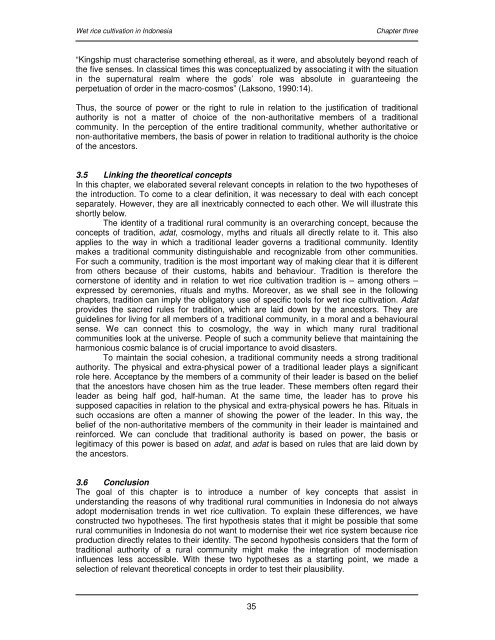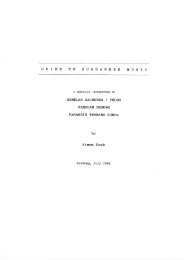Wet rice cultivation in Indonesia - Free EBooks Library
Wet rice cultivation in Indonesia - Free EBooks Library
Wet rice cultivation in Indonesia - Free EBooks Library
Create successful ePaper yourself
Turn your PDF publications into a flip-book with our unique Google optimized e-Paper software.
<strong>Wet</strong> <strong>rice</strong> <strong>cultivation</strong> <strong>in</strong> <strong>Indonesia</strong> Chapter three<br />
“K<strong>in</strong>gship must characterise someth<strong>in</strong>g ethereal, as it were, and absolutely beyond reach of<br />
the five senses. In classical times this was conceptualized by associat<strong>in</strong>g it with the situation<br />
<strong>in</strong> the supernatural realm where the gods’ role was absolute <strong>in</strong> guarantee<strong>in</strong>g the<br />
perpetuation of order <strong>in</strong> the macro-cosmos” (Laksono, 1990:14).<br />
Thus, the source of power or the right to rule <strong>in</strong> relation to the justification of traditional<br />
authority is not a matter of choice of the non-authoritative members of a traditional<br />
community. In the perception of the entire traditional community, whether authoritative or<br />
non-authoritative members, the basis of power <strong>in</strong> relation to traditional authority is the choice<br />
of the ancestors.<br />
3.5 L<strong>in</strong>k<strong>in</strong>g the theoretical concepts<br />
In this chapter, we elaborated several relevant concepts <strong>in</strong> relation to the two hypotheses of<br />
the <strong>in</strong>troduction. To come to a clear def<strong>in</strong>ition, it was necessary to deal with each concept<br />
separately. However, they are all <strong>in</strong>extricably connected to each other. We will illustrate this<br />
shortly below.<br />
The identity of a traditional rural community is an overarch<strong>in</strong>g concept, because the<br />
concepts of tradition, adat, cosmology, myths and rituals all directly relate to it. This also<br />
applies to the way <strong>in</strong> which a traditional leader governs a traditional community. Identity<br />
makes a traditional community dist<strong>in</strong>guishable and recognizable from other communities.<br />
For such a community, tradition is the most important way of mak<strong>in</strong>g clear that it is different<br />
from others because of their customs, habits and behaviour. Tradition is therefore the<br />
cornerstone of identity and <strong>in</strong> relation to wet <strong>rice</strong> <strong>cultivation</strong> tradition is – among others –<br />
expressed by ceremonies, rituals and myths. Moreover, as we shall see <strong>in</strong> the follow<strong>in</strong>g<br />
chapters, tradition can imply the obligatory use of specific tools for wet <strong>rice</strong> <strong>cultivation</strong>. Adat<br />
provides the sacred rules for tradition, which are laid down by the ancestors. They are<br />
guidel<strong>in</strong>es for liv<strong>in</strong>g for all members of a traditional community, <strong>in</strong> a moral and a behavioural<br />
sense. We can connect this to cosmology, the way <strong>in</strong> which many rural traditional<br />
communities look at the universe. People of such a community believe that ma<strong>in</strong>ta<strong>in</strong><strong>in</strong>g the<br />
harmonious cosmic balance is of crucial importance to avoid disasters.<br />
To ma<strong>in</strong>ta<strong>in</strong> the social cohesion, a traditional community needs a strong traditional<br />
authority. The physical and extra-physical power of a traditional leader plays a significant<br />
role here. Acceptance by the members of a community of their leader is based on the belief<br />
that the ancestors have chosen him as the true leader. These members often regard their<br />
leader as be<strong>in</strong>g half god, half-human. At the same time, the leader has to prove his<br />
supposed capacities <strong>in</strong> relation to the physical and extra-physical powers he has. Rituals <strong>in</strong><br />
such occasions are often a manner of show<strong>in</strong>g the power of the leader. In this way, the<br />
belief of the non-authoritative members of the community <strong>in</strong> their leader is ma<strong>in</strong>ta<strong>in</strong>ed and<br />
re<strong>in</strong>forced. We can conclude that traditional authority is based on power, the basis or<br />
legitimacy of this power is based on adat, and adat is based on rules that are laid down by<br />
the ancestors.<br />
3.6 Conclusion<br />
The goal of this chapter is to <strong>in</strong>troduce a number of key concepts that assist <strong>in</strong><br />
understand<strong>in</strong>g the reasons of why traditional rural communities <strong>in</strong> <strong>Indonesia</strong> do not always<br />
adopt modernisation trends <strong>in</strong> wet <strong>rice</strong> <strong>cultivation</strong>. To expla<strong>in</strong> these differences, we have<br />
constructed two hypotheses. The first hypothesis states that it might be possible that some<br />
rural communities <strong>in</strong> <strong>Indonesia</strong> do not want to modernise their wet <strong>rice</strong> system because <strong>rice</strong><br />
production directly relates to their identity. The second hypothesis considers that the form of<br />
traditional authority of a rural community might make the <strong>in</strong>tegration of modernisation<br />
<strong>in</strong>fluences less accessible. With these two hypotheses as a start<strong>in</strong>g po<strong>in</strong>t, we made a<br />
selection of relevant theoretical concepts <strong>in</strong> order to test their plausibility.<br />
35








